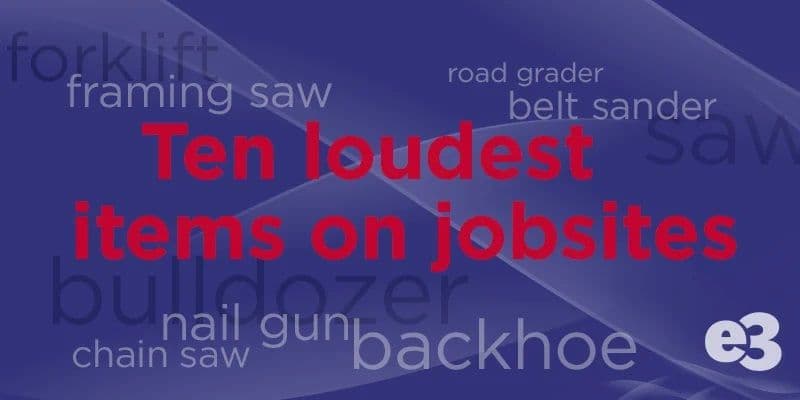10 Loudest Items on a Jobsite
Excessive exposure to loud noise is an unfortunate aspect of many jobs. When anyone is exposed to 8 hours of 85 dBA or higher every workday, without proper protection, damage can and usually does occur. So, which tools and equipment generate damaging levels of noise on the jobsite? Here’s a list of the top ten culprits, according to the Occupational Safety and Health Administration (OSHA).
#10 – FRAMING SAW (82 dBA)
With its 24 teeth sawing their way through wood, the framing saw registers just under the 85 dBA critical noise level.
#9 – BACKHOE (85 dBA)
Sitting inside the cab of a diesel-powered backhoe exposes a worker to a dangerous level of noise exposure.
#8 – BELT SANDER (90 dBA)
A handheld belt sander can reach up to 103 dBA, depending on the quality and condition of the tool. The noise level when the belt is running free is frequently higher than when it is in the sanding process. Worn sanding belts can also increase the noise level by adding a “flapping” sound to the mix.
#7 – FORKLIFT (93dBA)
The most damaging noise emitted from forklifts comes from the loud warning tones that sound when the machine is moving in reverse. When handling a large load, forklifts are generally driven backwards because it’s easier for the operator to see that way. That being said, that can mean a lot of loud noise exposure for the driver throughout the course of the workday.
#6 – NAIL GUN (97 dBA)
Two sources of loud noise emit from a nail gun. The first happens right after the operator pulls the trigger, which forces the piston ram into the front bumper. The second source of noise is the compressed air that exhausts out of the rear of the nail gun. Imagine being exposed to those sounds each and every time the trigger is pulled, usually just a second or two apart, for extended periods of time throughout the workday.
#5 – CONCRETE SAW, ELECTRIC GRINDER (98 dBA)
The motor, configuration and speed of the blade, and material being cut all significantly contribute to the noise level when using a concrete saw. With an electric grinder, the panels themselves often act as “loudspeakers” to increase the decibels.
#4 – BULLDOZER (100 dBA)
Even in the unloaded running stage, a bulldozer can emit a peak of 95.90 dBA. During the road construction stage, a dozer can reach up to a deafening 113.40 dBA. Needless to say, it’s wise to wear protection when operating one of these.
#3 – JACKHAMMER (102 dBA)
When you witness someone operating a stationary pneumatic jackhammer, you can see their entire upper torso shaking and vibrating. Taking that into consideration, think about what it can do to the ears. At a painful dBA of 102, unprotected exposure to jackhammer noise for as little as 1 hour per day can lead to moderate to severe hearing loss.
#2 - ROAD GRADER, SCRAPER (107 dBA)
Road graders and scrapers have an enclosed cab for the operator to sit in. In many cases, however, there is no insulation on the walls and no floor pad to dampen external noise. And, too, the cab doors are quite often left open during operation. It’s a loud machine that does little to muffle the sound it produces for the operator.
#1 – CHAINSAW (110 dBA)
Chainsaws aren’t just scary because they’re a favorite weapon of movie psychos. They’re also terrifying because of the damaging amount of noise they generate. When you combine the 2-cycle engine with the spinning of the chain, the chainsaw produces the highest decibel level of any tool or machine in the workplace. The more powerful and larger the saw, (you guessed it), the louder the noise. Not only is the operator at risk for hearing loss, but also anyone in proximity can have their hearing harmed by chainsaw noise. Now THAT is scary.





